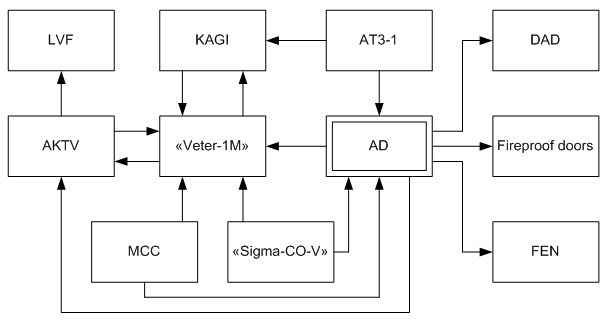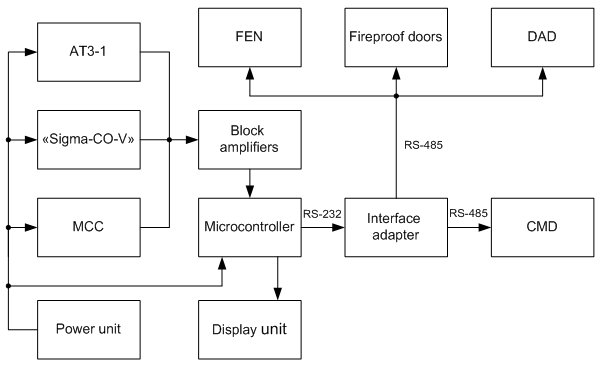 | | UKR
| | UKR | | ENG
| | ENG

For a modern coal mine safety of work is paramount. Timely warning of emergency situations and prevent their further development is the major task of the safety management of the mining enterprise. Such a system should provide a comprehensive multi-factor control [1] of the technological parameters of ventilation.
The greatest threat for safety of mining operations is the underground fires and explosions of methane. Dead-end workings are the most dangerous link in the network of underground workings of mines in Ukraine. In 1971-1999 years in dead-end workings were 36 explosions (40% of the total) and 102 cases of flares and combustion of methane. The main reason of the dangerous environment were violations of ventilation (44%), local concentrations of methane (22%) and lack of air flow (17%). Sources of ignition were blasting (70%), frictional sparks (20%) and electrical equipment (4%) [2]. In 1991-1998 years in coal mines occurred 138 endogenous and 461 exogenous fires [3].
Currently, the level of accidents and injuries in coal mines remains high, despite it's slight decline over the past few years. This implies, that apply in the present means of process control ventilation does not always provide reliable and effective protection.
Thus, the most important objective in the field of process automation in the coal industry is the creation of complex management systems, which provide speedy adoption of optimal management decisions at different hierarchical levels, forecast of dangerous situations, maintaining a rational mode of operation of the controlled objects, reducing downtime and increasing equipment mine safety.
The purpose of master's work is the development comprehensive mine safety system in dead-end workings, which provide the control parameters of the process of ventilation, gas and fire protection.
Tasks of master's work are:
research characteristics and features of the process of ventilation of blind workings in normal and emergency conditions;
analysis studies and developing in the creation of integrated safety of mining operations;
evaluating the effectiveness of the existing systems of gas and fire protection;
formation requirements for developed safety system based on identified shortcomings of systems;
development of technical solutions for integrated safety system of mining operations in view of making claims.
For mining enterprises in Ukraine the problem of increasing efficiency in the fight with underground fires and explosions of methane is of particular relevance in view of the continuing complexity of geological conditions, development of deeper horizons, increasing available power mines, mechanization of production processes. Thus, the intensification of mining activities, on the one hand, and the lack of a systematic approach to providing emergency protection, on the other hand, increases the likelihood of a hazard in the event retain the level of safety.
Safety of mining operations depends on the reliability of forecasting methods emergencies and effective ways to prevent them. Currently, the mining industry is no steady downward trend in accidents in mines, which requires the improvement of safety management and occupational safety at the plant.
Figure 1 shows the structure of the developed automatic control system of mine safety in dead-end workings, which designed to control the process parameters of ventilation, gas and fire protection.

Figure 1 – Structure of the automatic control system of mine safety
Continuous automatic control of parameters mine atmosphere is carried out by methane sensor AT3-1 and carbon monoxide detector "Sigma-CO-V". The measurement of the operating parameters of local ventilation fans (LVF) is carried out by the equipment AKTV. Management of LVF implemented by the equipment AKTV with a telemetry device "Veter-1M".
For the liberation working in the event of excessive of methane in accordance with the Rules of safety [4] used a special device auto-degassing (DAD), which is a tube with a cross section of a circular or rectangular shape with a valve regulating the flow of air in the mine.
To eliminate the underground fires uses membrane installation of automatic fire extinguishing nitrogen (FEN), which is a hi-tech facility for obtaining nitrogen from the air [5]. The main units of the FEN are installed compressor block, air treatment, gas separation unit and control system. Gas separation unit consists of special modules, which produce nitrogen from atmospheric air required purity. The work principle of membrane systems based on different speed penetration of gas components through the membrane material. The driving force of the gas separation is the difference in partial pressures on different sides of the membrane.
Control of fireproof doors, which preventing the spread of flames to other makings and carrying out the role of jumpers for isolation disaster space, performed by magnetically controlled contacts (MCC).
For supervisory control of the ventilation of blind makings use hardware-software complex KAGI, which providing processing, analysis and visualization of information about the monitored parameters.
Management of the gas and fire protection is carried out by designed automation device (AD), which is shown in Figure 2.

Figure 2 – Scheme of the process automation device of ventilation
The signals from the methane sensor AT3-1, carbon monoxide detector "Sigma-CO-V" and magnetic sensors of fireproof doors MCC through the block amplifiers come in a microcontroller for comparison with the set point response apparatus of the gas and fire protection. The microcontroller processes the data obtained. In the case of an emergency related with increasing methane or carbon dioxide concentration to limit values microcontroller generates control commands to process automation systems installation.
Information about the controlled process parameters of ventilation and functioning mode of technological complex equipment is indicated by the display unit.
To convert the RS-232 interface, which used by a microcontroller, on RS-485 interface is used a special adapter, which allowing to enhance the technical characteristics of the device automation and robustness of communication channels.
Through the interface adapter information about the monitored parameters and data about work of technological protection means from the microcontroller are transmitted to the console mining dispatcher (CMD).
Thus, the application of the developed control system improves the efficiency, reliability and safety of mining operations, provides a prediction and prevention of emergencies and rapid adoption of measures to eliminate them.
Nowadays for mining industry of Ukraine the most important challenge is ensuring safety work through the creation of early warning emergency systems, which aimed at preventing and eliminating underground fires and methane explosions.
At this time paramount problem is complex equipping of coal mines by continuously operating gas and fire protection, which allowing to organize the effective work of ventilation system.
Developed safety management system greatly improves the efficiency of prediction and prevention of emergencies in dead workings of coal mines, which associated with underground fires and explosions of methane, increases the level of mine safety and health at the enterprise.
Note. At the time of writing this abstract master's work is not yet completed. The final completion - December 2011 Full text of the work and materials on the subject can be obtained from the author or his scientific advancer after that date.
Научные основы автоматизации в угольной промышленности: опыт и перспективы развития: монография / В.Г. Курносов, В.И. Силаев; Международный институт независимых педагогических исследований МИНПИ-ЮНЕСКО, ОАО «АВТОМАТГОРМАШ им. В.А. Антипова». – Донецк: изд-во «Вебер» (Донецкое отделение), 2009. – 422 с.
Бусыгин К.К., Кошман А.В. Повышение эффективности аэрогазового контроля в тупиковых выработках // Уголь Украины. – 2001. – №7. – с. 34-36
Азаров С.И. Анализ риска при пожаре в угольной шахте // Уголь Украины. – 2001. – №2-3. – с. 43-45
Правила безпеки у вугільних шахтах. ДНАОП 1.1.30-1.01-00. – Киев, 2001. – 484 с.
Мембранные азотные установки и станции. Каталог продукции компании «Грасис». – Электронный ресурс. – Режим доступа: http://www.grasys.ru/upload/iblock/65e/membrane_2.pdf
© Krasyukova Nataliya, DonNTU